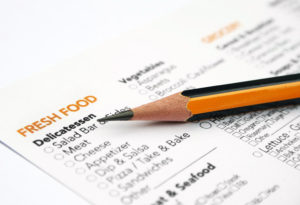13 Tips For Eating On A Budget

Feeding a family can be an expensive so it’s unfortunate when unused food goes to waste. More than 1/3 of food produced globally is wasted or spoiled. Americans throw away up to 40% of the food they buy, and organic matter in landfills provides 20% of methane emissions, a potent greenhouse gas that contributes considerably to climate change. Maximizing the food you buy is not only about combating waste, it is just good common sense. Here are some tips that can help:
1.Fresh herbs often come in larger quantities than a cook can use before they go bad. Instead of letting the unused portions go to waste, chop up leftover herbs, measure into ice cube trays with water, and freeze to make lovely herb-infused ice cubes! Toss a few cubes into soups and stews or mix with butter for sautéing vegetables and meats.
2. Propagate your produce! If your potatoes have “eyes” or look less than fresh, consider planting them in the ground. Grow potatoes indoors in winter if you live in a cold climate, then plant outdoors in spring. Herbs can be placed in water until roots grow and potted for the rest of the season.
3. Use cheaper yet still tasty cuts of meat like pork shoulder to feed a crowd. A pork shoulder costs less than $2/lb and 6lbs can feed up to eight people!
4. Live on, bananas! Wrap the stems of separated bananas with plastic wrap to extend their life
5. Freeze staples work. Everyone knows to buy certain foods in bulk and freeze the excess, but this principal can extend beyond just chicken breasts. When staples like butter go on sale, grab extra for freezing. Individually wrapped sticks can go straight into the freezer and keep for up to six months before thawing in the fridge. Bread and berries stay fresh for up to one year, milk for three months, and fresh orange juice for four.
6. Take easy-to-make foods off your grocery list and make them yourself. As simple as it is to pick up a bottle of salad dressing or a carton of chicken stock at the store, it’s almost as easy, and certainly cheaper to make it at home. To make hummus, for example, toss chickpeas, olive oil, and a few other basic ingredients into a food processor, and it’s ready to eat.
7. Use plates with lids. Don’t you hate it when your kids take a few bites of a meal, then declare they are full? Rather than waste food by tossing leftovers in the trash, simply snap a lid on top of the plate so the meal doesn’t take on off flavors in the fridge and serve later when they get hungry again.
8. Make infused water. Plain water can get boring, but alternatives such as coconut water and sports drinks are expensive. Infusions can give water a touch of flavor, making it exciting to the palate and encouraging hydration. Don’t just limit it to cucumbers and oranges. Try plucking some branches from your evergreen to make pine-infused water, which pairs well with smoked meats and other strong flavors.
9. Hide leftovers in a new dish. It’s easy to buy more vegetables or meats than needed for a recipe, and too often these perishable items go to waste. Do a sweep and gather all the stragglers into a soup, pasta, or stir-fry. Stale bread can be re-purposed as French toast or croutons. Leftover meat is perfect for making homemade broth. Pulp from fruit can be simmered down and strained to create a perfect healthful flavored tea. Leftover citrus peels can be dried on low heat in the oven and then added to stews and sauces to revitalize flavors.
10. Label your leftovers so you can keep track of how long they’ve been in your fridge or freezer, and incorporate them into your daily or weekly routine.
11. Out of sight can be out of mind however, when it comes to storing food. Keep thinks neat and visible in your fridge and freezer and use the “first in, first out” principle: after you buy new groceries, move the older products to the front so you consume them first.
12. Try canning or pickling. Canning is a great way to preserve your food, especially fruit, and increases its shelf life for months.
13. Leftover beverages from a party don’t have to be wasted either. The flavor and sugar content of dark sodas makes for thick and flavorful sauces — try using cola to make a tangy barbecue sauce. Citrus sodas can stop the oxidation process that browns your fruit or add to your watering can as the citric acid and sugar will give your growing flowers a boost. The carbon dioxide and alcohol in beer makes it a great ingredient to make a crisp and flavorful batter and beer can make a rich and flavorable marinade, plus is an effective tenderizer for your meats.
Source: http://www.coca-colacompany.
• 2 teaspoons canola oil
• 2 tablespoons finely minced onion (about ¼ onion)
• 1 cup ketchup
• 1 cup Coca-Cola
• 3 tablespoons Worcestershire sauce
• 1 teaspoon garlic powder
• ½ teaspoon black pepper
• ½ teaspoon liquid smoke (optional)
• ¼ cup chopped or shredded pineapple, drained
• ½ teaspoon hot sauce
• Grilled sweet potato wedges or vegetables, for dippingDirections
Warm a medium saucepan over medium heat. Add canola oil and onion and cook, stirring constantly, until onion is translucent, 2 minutes. Add in ketchup, coke, Worcestershire sauce, garlic powder, pepper and liquid smoke, increase heat to high, and bring to a boil, stirring constantly. Then reduce heat to medium-low until sauce reduces and thickens, 7 to 10 minutes. Stir every 30 seconds or so. Remove from heat and let cool.



